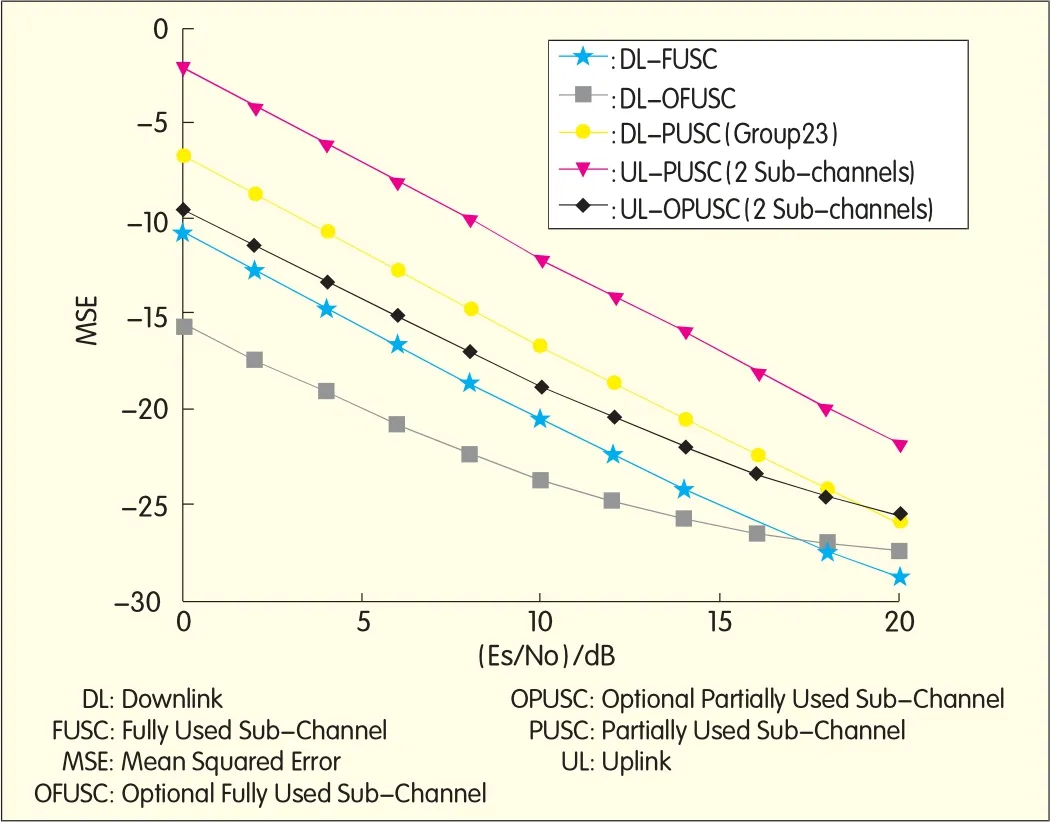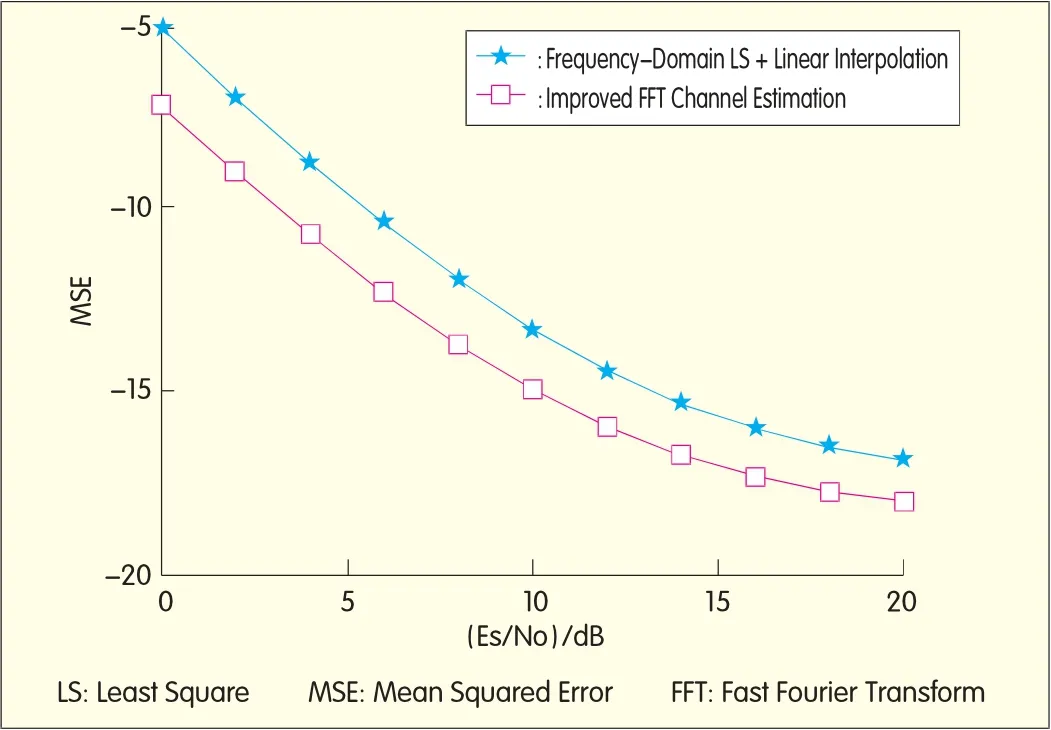Pilot and Channel Estimation for WiMAX System
Liu Gngi1 Wang Yong Zhang Jianh
(1. Research Institute of China Mobile, Beijing 100053, China;
2. Wireless Technology Innovation Institute of Beijing University of Posts and Telecommunications, Beijing 100876, China)
Abstrac t:Orthogonal Frequency Division Multiplexing(OFDM)is very suitable for high data rate transmission in wide band wireless channel for the excellent capability to mitigate the frequency selective fading and Inter-Symbol Interference(ISI).In WiMAX system,Orthogonal Frequency Division Multiple Access(OFDMA)is adopted as the basic multiple access scheme,and different pilot patterns has been defined for both uplink and downlink channels.Pilot pattern should be changed,especially when Multiple Input Multiple Output(MIMO)technique is combined with OFDMA,in order to support multiple antennas.There are five pilot patterns in the WiMAX-MIMO-OFDMA system,namely:Downlink-Partially Used Sub-Channel(DL-PUSC),Downlink-Fully Used Sub-Channel(DL-FUSC),Downlink-Optional Fully Used Sub-Channel(DL-OFUSC),Uplink-Partially Used Sub-Channel(UL-PUSC)and Uplink-Optional Partially Used Sub-Channel(UL-OPUSC).Moreover,by analyzing the simulation results of time domain Least Square(LS),frequency domain LS,and Fast Fourier Transform(FFT)-based channel estimation algorithms,the best pilot pattern can be found.Based on the simulation comparison of several channel estimation methods in the WiMAX-MIMO-OFDMA system presented in this article,the best channel estimation for each pilot pattern is concluded.
W iMAXis a broadband wireless access technology based on the IEEE 802.16 family of standards.It supports four application scenarios such as fixed,nomadic,portable and full mobility.The IEEE 802.16 standards can be divided into the fixed broadband wireless access air interface standard(802.16d),and the mobile broadband wireless access air interface standard(802.16e),which is considered in the industry as the next-generation broadband wireless technology that can be comparable to 3G since it supports mobility and delivers high-speed data services at low cost.For both 802.16d and 802.16e,Orthogonal Frequency Division Multiple Access(OFDMA)[1-2]is adopted as the core physical layer technology since it is very suitable for high data rate transmission in wide band wireless channel for its excellent capability to mitigate the frequency selective fading and Inter-Symbol Interference(ISI).
For OFDMA system,channel estimation is a key technique.The accuracy of channel estimation has great impact on the system performance,especially when Multiple Input Multiple Output(MIMO)and high-order modulation techniques are combined with OFDMA.By far,many methods for Single Input Single Output-Orthogonal Frequency Division Multiplexing(SISO-OFDM)channel estimation are available,such as the frequency domain channelestimation based on Least Square(LS),channel estimation based on Fast Fourier Transform(FFT),time domain channelestimation based on the LSprinciple and Minimum Mean Square Error(MMSE)principle,and blind channelestimation.These methods have their own advantages and disadvantages,and they function differently in different systems.
The uplink and downlink of an OFDMA system operate on different principles.The downlink is a broadcast channel that conforms to the idea of Orthogonal Frequency Division Multiplexing(OFDM)channelestimation.In the uplink,however,each user communicates with the base station on a random basis and corresponds to its own multi-path fading channel.
Therefore,the uplink channel estimation must be done respectively.When the MIMO technique is combined with the OFDMA system,the signals received are the overlap of signals from multiple transmit antennas.As interference occurs in different antennas and the accuracy of channel estimation has great impact on the system performance,the MIMO system poses a higher requirement on the accuracy of channel estimation than the SISO system.Moreover,the 802.16d and 802.16e standards define a variety of sub-channel allocation solutions for the uplink and downlink to adapt to different scenarios.As pilot overheads and patterns are different in these allocation solutions,different channel estimation methods should be adopted.In other words,channel estimation under different pilot modes is of great significance in studying theWiMAX-MIMO-OFDMAsystem.
1 WiMAX-MIMO-OFDMA System Model
The transmitting/receiving process of the WiMAX-MIMO-OFDMAsystem is related to the OFDMA sub-channel allocation,MIMO technique and coding matrix.It can be designed in many frame structures[1].At the transmitter,a number of operations such as coding,interleaving,modulation,sub-channelization,MIMO coding,pilot interpolation,Inverse Fast Fourier Transform(IFFT),filtering,Digital/Analog(D/A)conversion,and Radio Frequency(RF)modulation are involved.
The execution order of these operations varies with specific conditions.The process at the receiver is the reverse of that at the sender.
OFDMA sub-channel allocation falls into two types:Fully Used Sub-Channel(FUSC)and Partially Used Sub-Channel(PUSC).FUSC is designed to first select pilot sub-carriers and then divide the remaining into sub-channels for data transmission.On the other hand,PUSC is designed to first divide available sub-carriers into sub-channels and then select pilot sub-carriers from each sub-channel.
The MIMO technique includes transmit diversity and space multiplexing[3].In the WiMAXsystem,MIMO is combined with OFDM,and the MIMO schemes support Space Time Block Coding(STBC),Space Frequency Block Coding(SFBC),Frequency Hopping Diversity Coding(FHDC),Vertical-Bell Laboratories Layered Space Time(V-BLAST)and Horizontal-Bell Laboratories Layered Space Time(H-BLAST)[1].Moreover,it supports two,three or four transmit antennas on the downlink,and only two transmit antennas on the uplink[1].For different number of transmit antennas,coding matrices A,Band C are available[1-2].
Sub-carriers in the WiMAXsystem are divided into three types:data sub-carriers used for data transmission,pilot sub-carriers for various estimations and synchronizations,and null sub-carriers(including guard sub-carriers and Direct Current(DC)sub-carriers)not used for transmission[4].
802.16e aims to be backward compatible with 802.16d.It has basically the same physicallayer implementation as 802.16d.The main difference is that 802.16e is a further expansion of OFDMA.802.16d specifies 2 048 sub-carriers in OFDMAwhile 802.16e can support 128,512,1 024 and 2048 sub-carriers in OFDMAto adapt to the bandwidth span from 1.25 MHz to 20 MHz.The channel estimation in this article is not only intended for 802.16e,but also applicable to 802.16d.
2 Pilot Patterns in the WiMAX-MIMO-OFDMA System
The downlink sub-channelallocation methods adopted in the OFDMA system include Downlink-Partially Used Sub-Channel(DL-PUSC),Downlink-Fully Used Sub-Channel(DL-FUSC),Downlink-Optional Fully Used Sub-Channel(DL-OFUSC)and optional Adaptive Modulation and Coding(AMC)sub-channel allocation.The uplink sub-channel allocation methods include Uplink-Partially Used Sub-Channel(UL-PUSC),Uplink-Optional Partially Used Sub-Channel(UL-OPUSC)and optional AMC sub-channel allocation[1].Five of these allocation methods are introduced in this article.

▲Figure 1. Basic cluster structure for DL-PUSC.
2.1 DL-PUSC
In DL-PUSC,the available sub-carriers(data and pilot sub-carriers)are divided into basic clusters.A sub-channel consists of two basic clusters.Acluster contains two symbols,with each occupying 14 sub-carriers,as shown in Figure 1.
Based on the division of basic clusters,allpilots in DL-PUSC are divided into six groups.The six groups are then allocated to different sectors and each sector can use one or multiple groups.DL-PUSC supports two or four transmit antennas.Pilots between different antennas are differentiated by time and frequency domains,and have a cycle of four time symbols.
2.2 DL-FUSC
In DL-FUSC,pilot sub-carriers are first selected from the available sub-carriers,and then,the remaining data sub-carriers are divided into sub-channels.Pilot sub-carriers are divided into fixed and variable pilots,which include two variable pilot-sets and constant pilot-sets respectively.The number and location of pilot sub-carriers in the pilot-sets vary with the number of sub-carriers[1].The constant pilot-sets do not vary with time.But the variable pilot-sets make changes according to odd and even symbols,and their location is calculated by using formula(1):PilotLocation=VariableSet#x+6×(SymbolNumber mod 2) (1)
where x =0 or 1,SymbolNumber represents the mthsymbol,and m starts from 0.
DL-FUSCsupports two or four transmit antennas,and its change obeys the following rules:
(1)For two transmit antennas:In the even symbols,antenna 0 uses the VariableSet#0 and ConstantSet#0,and antenna 1 uses the VariableSet#1 and ConstantSet#1.In the odd symbols,antenna 0 uses the VariableSet#1 and ConstantSet#0,and antenna 1 uses the VariableSet#0 and ConstantSet#1.The location of variable pilot sub-carriers varies every 2 symbols,as shown in the formula(2):PilotLocation=VariableSet#x+

(2)For four transmit antennas:In the even symbols,antenna 0 uses the VariableSet#0 and ConstantSet#0,antenna 1 uses the VariableSet#1 and ConstantSet#1,antenna 2 uses the VariableSet#0+1,and antenna 3 uses the VariableSet#1+1.In the odd symbols,antenna 0 uses the VariableSet#1,antenna 1 uses the VariableSet#0,antenna 2 uses the VariableSet#1+1 and ConstantSet#0,and antenna 3 uses the VariableSet#0+1 and ConstantSet#1.The location of variable pilot sub-carriers also varies every two symbols.

▲Figure 2. Tile structure for UL-PUSC (a single transmit antenna).
2.3 DL-OFUSC
DL-OFUSCuses all sub-channels in a manner similar to DL-FUSC,where pilot sub-carriers are first allocated and then the remaining data sub-carriers are divided into sub-channels.In DL-OFUSC,the available sub-carriers are divided into several groups,with each group consisting of nine sub-carriers.A pilot sub-carrier is allocated in each group and its location varies with the time sequence of OFDMA symbols.If the numbers of the nine contiguous sub-carriers are 0 to 8,the number of the pilot sub-carrier will be 31+1,where 1=m mod3(m is the sequence number of OFDMA symbols).DL-OFUSC supports two,three,or four transmit antennas.
2.4 UL-PUSC
In UL-PUSC,all available sub-carriers are first divided into tiles,with each tile comprising four consecutive sub-carriers by three consecutive symbols.The pilot sub-carriers are located at the four corners of each tile,as shown in Figure 2.A sub-channel consists of six noncontiguous tiles.UL-PUSC supports two transmit antennas at most,and its change follows the rule illustrated in Figure 3.
2.5 UL-OPUSC
In UL-OPUSC,each sub-channel contains 6 tiles,with each tile comprising three consecutive sub-carriers by three consecutive symbols.The pilot sub-carrier is located at the second symbol of the second sub-carrier.UL-OPUSC supports 2 transmit antennas at most.
2.6 Comparison of 5 Pilot Patterns
(1)The Number of Allocated Pilots
DL-FUSC and DL-OFUSC are pilot patterns in the downlink,which use all sub-channels and can get all pilot signals at the receiver.DL-PUSC is the downlink pilot pattern that uses a portion of sub-channels,where each sector uses one or multiple pilot groups,and the number of pilots obtained at the receiver has connection with the number and type of pilot groups being used.UL-PUSC and UL-OPUSC are the uplink pilot patterns that use a portion of sub-channels,where a user is allocated one or multiple sub-channels,and the number of pilots obtained at the receiver is related to the number of allocated sub-channels.
(2)Pilot Overhead
UL-PUSC>UL-OPUSC>DL-PUSC>DL-OFUSC>DL-FUSC
(3)Pilot Power
In DL-PUSC,DL-FUSC,DL-OFUSCand UL-OPUSC,the pilot power is 2.5 d B higher than the average data power.In UL-PUSC,the pilot power is equal to the average data power.
3 Channel Estimation in WiMAX-MIMO-OFDMA System
There are various methods available for channel estimation.This article will research three typical channel estimation methods.The simulation conditions are as follows:1 024 sub-carriers,3.5 GHz carriers,6-ray Typical Urban(TU)channel model[5],64 cyclic prefix,transmit antenna 1 and transmit antenna 2,a vehicle speed of 50 km/h,and 1/2 convolutional coding and interleaving.
3.1 Time-Domain LS Channel Estimation

3.1.1 Algorithm Principle
The time-domain LSchannel estimator is actually a de-correlator,in which channel characteristics are derived by multiplying the receiving signals by a pseudo-inverse matrix.The algorithm is based on the assumption that the receiver knows the specific delay of each ray but not the specific gain.
If there are M pilotson{ai(mk)},k=0,1…M-1 on a time symbol of a transmit antenna(where i is the transmit antenna i,Mkis the kthpilot sub-carrier,mk∈{0…N-1},and N is the number of sub-carriers),the received pilot signals are shown as a matrix in formula(3)(the receiving antenna and time sequence are omitted for simplification):

Whereτi,i=0,…,L-1 is the delay of each ray,and Tuis a symbol cycle.
For(Tpi)HTpi=d I,where d is a constant and I is an identity matrix.The time-domain channel impulse response is shown in formula(5):

If the above hLSis converted to the frequency domain,the necessary frequency-domain channel impulse response can be obtained.
3.1.2 Performance Simulation and Analysis

▲Figure 3. Tile structure for UL-PUSC (2 transmit antennas).
The number of allocated pilots has great impact on the time-domain LSchannel estimator.Therefore,the estimator is quite suitable for DL-FUSC and DL-OFUSC.Generally,the estimator will not be adopted for DL-PUSC if only one pilot group is allocated.For the uplink pilot patterns,the estimator can not be used unless more than two sub-channels are allocated to a user.Moreover,the estimation performance is associated with pilot power.Under the condition of the same number of pilot carriers,UL-PUSC provides a relatively poor performance.Illustrated in Figure 4 is the Mean Squared Error(MSE)performance of time-domain LSchannel estimation.

▲Figure 4. MSE performance of time-domain LS channel estimation.

▲Figure 5. MSE performance of various interpolation methods.
3.2 Frequency-Domain LS Channel Estimation and Interpolation
The pilot patterns in the WiMAX-MIMO-OFDMA system are two-dimensional in discrete.Frequency-domain LSchannel estimation of the kthsub-carrieris given in formula(6):

where Y(k),H(k),p(k)and W(k),and respectively represent the receiving signals,channel frequency response,pilot signals and white Gaussian noise of the kthsub-carrier.
In the WiMAXsystem,guard sub-carriers are defined and pilots are not interpolated at an interval of the Nthpower of 2.Thus,formula(6)can not be simplified,and requires complex reverse calculation.The current hardware conditions can hardly meet the requirement.Moreover,this algorithm must know,in advance,the multi-path time delay,which brings some inconvenience for channel estimation.
For the frequency-domain LSchannel estimation,the channel state information about the discrete points can be obtained.To receive channel responses at all sub-carriers,an interpolation method must be used.So far,three interpolation methods are available:linear interpolation,three-order spline interpolation and nearest interpolation.Linear interpolation uses a straight line to connect the neighboring data points and complete the interpolation.Spline interpolation uses known data to get a spline function and perform the interpolation where the smoothest curve can be generated.However,when data are unevenly distributed,the result is undesirable.Nearest interpolation is performed on the basis of the interpolation point and location distance of the two known points.It is easy to implement but provides the roughest estimation.These interpolation methods are not applicable to all pilot patterns because the result of interpolation is associated with the specific pilot density,pilot power and pilot pattern.Given below is an analysis of the interpolation method adopted in different pilot patterns.
(1)DL-PUSC:Interpolation for DL-PUSC is based on clusters.Each time symbol of each antenna in the cluster is allocated a pilot sub-carrier.Therefore,only the nearest interpolation can be adopted.
(2)DL-FUSC:The above three interpolation methods can be adopted for DL-FUSC.As pilots in DL-FUSC are unevenly distributed,both spline and nearest interpolation methods,however,yield poor performance.Therefore,linear interpolation is the best choice.
(3)DL-OFUSC:The above three interpolation methods can be adopted for DL-OFUSC,where pilots are evenly distributed.For a high signal-to-noise ratio,spline interpolation yields better performance than linear interpolation.But for a low signal-to-noise ratio,the performance of spline interpolation is inferior to that of linear interpolation due to the effect caused by noise.
(4)UL-PUSC:Interpolation for DL-PUSC is based on tiles.On each time symbol,each antenna in the tile is allocated at most a pilot sub-carrier.Therefore,only the nearest interpolation can be adopted.
(5)UL-OPUSC:Both linear and nearest interpolation methods can be adopted for UL-OPUSC.However,linear interpolation performs better.
Another most commonly used interpolation method is filter interpolation(such as Wiener interpolation),which is not explained here due to its high complexity.Figure 5 shows the MSEperformance of various interpolation methods.
3.3 FFT-based Channel Estimation
The FFT-based channel estimation is only applicable to interpolation at an intervalof the n-th power of 2(n is a non-negative integer).In the WiMAX-MIMO-OFDMA system,however,guard sub-carriers are defined and pilots are not interpolated at an interval of the n-th power of 2.Thus,some changes must be made to the FFT-based channel estimation as described in the following steps:

▲Figure 6. MSE performance comparison for DL-OFUSC.
·Adopt the frequency-domain LSalgorithm to get the frequency-domain channel response at the pilot sub-carriers;
·Interpolate the discrete channel state information to get the frequency-domain channelresponse at the available sub-carriers;
·Build the frequency-domain continuity,i.e.,interpolate a part of the guard sub-carriers(adopt linear interpolation due to complexity)to get the frequency-domain response at the N point HLS;
·Use IFFTto convert HLS(k)to the time domain:h1(n)=IFFT[HLS];
·Keep the prefix point Lcp(length of cyclic prefix)and the tail point Ltail(determined by the current channeltype and the number of pilots)of h1and set the middle to 0,thus reducing noise effect;

·Use FFTto convert to h2(k)the frequency domain to get the necessary channel estimation:HFFT(k)=FFT[h2(n)].
The above channel estimation method is applicable for DL-FUSC and DL-OFUSC.But it is not recommended for DL-FUSC in view of the poor interpolation performance caused by unevenly distributed pilots.The MSEperformance comparison for DL-OFUSCis shown in Figure 6.
4 Conclusions
Based on the simulation comparison of several channel estimation methods in the WiMAX-MIMO-OFDMAsystem presented in this article,the best channel estimation for each pilot pattern is concluded as follows:
(1)DL-PUSC:When more pilots are allocated,the optimal method is time-domain channel estimation.Otherwise,frequency-domain LSchannel estimation and nearest interpolation shall be adopted.
(2)DL-FUSC:The time-domain LSchannel estimation is the best choice because other choices provide poor performance.
(3)DL-OFUSC:The time-domain LSchannel estimation is the first choice and the improved FFTchannel estimation is the second choice.
(4)UL-PUSC:When more sub-channels are allocated to a user,time-domain LSchannel estimation is the optimal choice.Otherwise,frequency-domain LSchannel estimation and nearest interpolation shall be adopted.
(5)UL-OPUSC:When more sub-channels are allocated to a user,time-domain LSchannel estimation is the finest choice.Otherwise,frequency-domain LSchannel estimation and linear interpolation shall be adopted.However,considering the current hardware environment,it is difficult to implement time-domain LSchannel estimation.Therefore,the second best estimation approach can be adopted.
- ZTE Communications的其它文章
- Upgrade and Optimization Scheme: GSM Intelligent Network to DestinationNetwork
- Mobile Ubiquitous Service Environment
- Soft Site Swap and Cutover in WCDMA Network
- Handoff Algorithms for Integrated Ad Hoc and Mobile Cellular Systems
- Security Technologies for NGN
- ZTE Delivers a Record 10 Million Handsets in India

